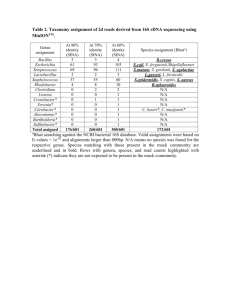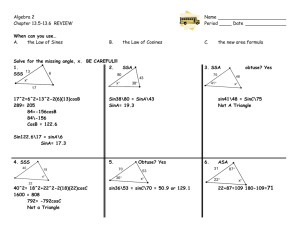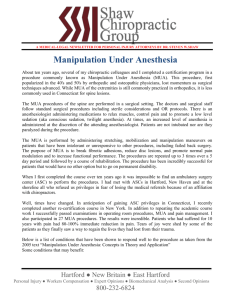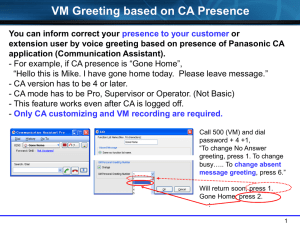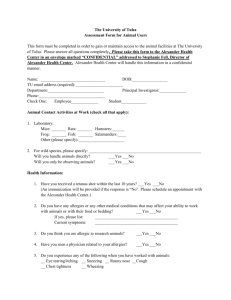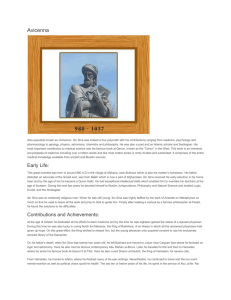Tālofa, `O ā Mai `Oe
advertisement
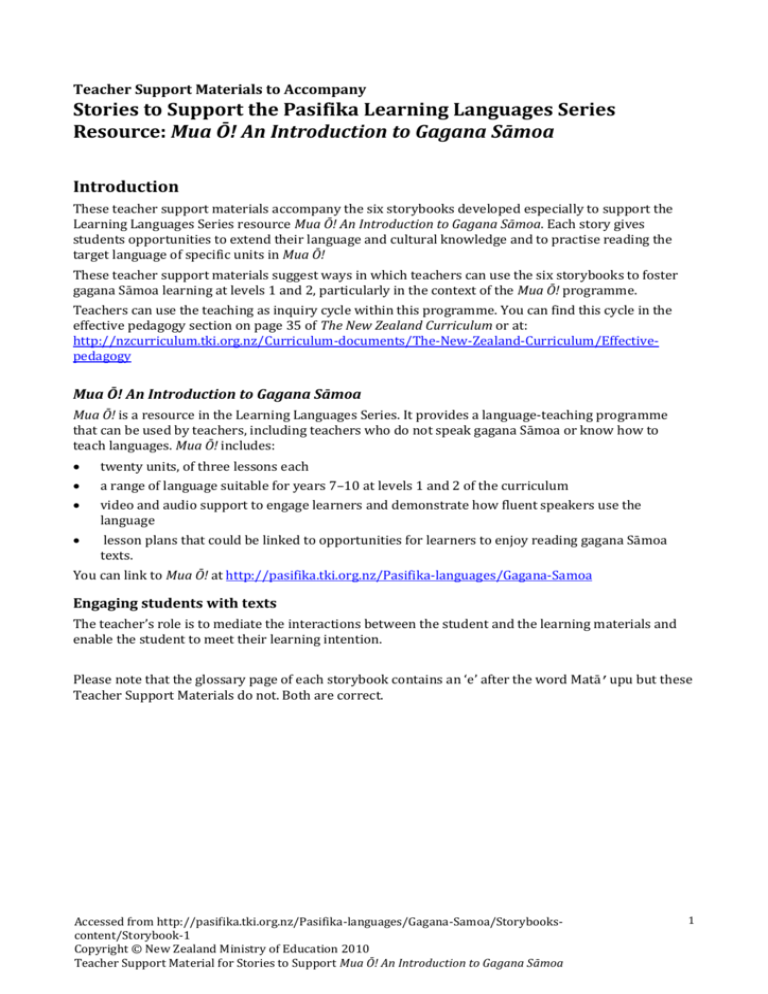
Teacher Support Materials to Accompany Stories to Support the Pasifika Learning Languages Series Resource: Mua Ō! An Introduction to Gagana Sāmoa Introduction These teacher support materials accompany the six storybooks developed especially to support the Learning Languages Series resource Mua Ō! An Introduction to Gagana Sāmoa. Each story gives students opportunities to extend their language and cultural knowledge and to practise reading the target language of specific units in Mua Ō! These teacher support materials suggest ways in which teachers can use the six storybooks to foster gagana Sāmoa learning at levels 1 and 2, particularly in the context of the Mua Ō! programme. Teachers can use the teaching as inquiry cycle within this programme. You can find this cycle in the effective pedagogy section on page 35 of The New Zealand Curriculum or at: http://nzcurriculum.tki.org.nz/Curriculum-documents/The-New-Zealand-Curriculum/Effectivepedagogy Mua Ō! An Introduction to Gagana Sāmoa Mua Ō! is a resource in the Learning Languages Series. It provides a language-teaching programme that can be used by teachers, including teachers who do not speak gagana Sāmoa or know how to teach languages. Mua Ō! includes: twenty units, of three lessons each a range of language suitable for years 7–10 at levels 1 and 2 of the curriculum video and audio support to engage learners and demonstrate how fluent speakers use the language lesson plans that could be linked to opportunities for learners to enjoy reading gagana Sāmoa texts. You can link to Mua Ō! at http://pasifika.tki.org.nz/Pasifika-languages/Gagana-Samoa Engaging students with texts The teacher’s role is to mediate the interactions between the student and the learning materials and enable the student to meet their learning intention. Please note that the glossary page of each storybook contains an ‘e’ after the word Matā’upu but these Teacher Support Materials do not. Both are correct. Accessed from http://pasifika.tki.org.nz/Pasifika-languages/Gagana-Samoa/Storybookscontent/Storybook-1 Copyright © New Zealand Ministry of Education 2010 Teacher Support Material for Stories to Support Mua Ō! An Introduction to Gagana Sāmoa 1 Tālofa, ‘O ā Mai ‘Oe? na tūsia e Fatulatetele T. Tolo This story supports Matā‘upu 2 (Tālofa lava/Formal greetings). Text Features The language features of this story include: the comic-book format a visual story (the dog following Alexander to school, though the boy is unaware of it, and his mother trying to find the dog) formal and informal greetings, for example, Tālofa, Alexander [formal greeting], Tālofa lava, lau susuga Mrs Tanielu [formal greeting from a young person to an adult], Mālō, Alex [everyday greeting], Mālō, suga [informal greeting from a peer to a female], Mālō, sole [informal greeting from a peer to a male] the repeated question, ‘O ā mai ‘oe?, ‘O ā mai ‘oulua?, ‘O ā mai ‘outou? personal pronouns, for example, ‘oe [one person], ‘oulua [two people], ‘outou [three or more people] possessive pronouns, for example, o‘u, lau, lo‘u, la‘u the new colloquialism Seki ā …/the best, that’s cool, which is commonly used by young people and increasingly by adults too. The cultural features of this story include: the need to use respectful language when speaking to an older person. Supports and Challenges Students who have completed Matā‘upu 1 and Matā‘upu 2 of Mua Ō! may find it easy to: identify the different types of greetings that are used between different people identify the question ‘O ā mai ‘oe? and the personal pronouns that are used with it. These students may find it challenging to: identify all of the different possessive pronouns that are used understand some new vocabulary, phrases, and sentences (these are in the book’s glossary or the glossary of Mua Ō!). Planning: Teaching as Inquiry Consider your students’ interests and their ability to read in gagana Sāmoa at this level and choose activities that provide appropriate content and support. Assess and reflect on the effectiveness of your teaching and the students’ learning, then plan next steps. Accessed from http://pasifika.tki.org.nz/Pasifika-languages/Gagana-Samoa/Storybookscontent/Storybook-1 Copyright © New Zealand Ministry of Education 2010 Teacher Support Material for Stories to Support Mua Ō! An Introduction to Gagana Sāmoa 2 Curriculum Links and Links to Mua Ō! An Introduction to Gagana Sāmoa The New Zealand Curriculum: Learning Languages Students can understand and use familiar expressions and everyday vocabulary. (levels 1 and 2) Students will recognise that the target language is organised in particular ways. (levels 1 and 2) Ta‘iala mo le Gagana Sāmoa: The Gagana Sāmoa Guidelines Students will: give and respond to greetings, farewells … (level 1) recognise and express fa‘aaloalo in a variety of contexts (level 1) make connections with known culture(s). (level 1) Mua Ō! An Introduction to Gagana Sāmoa Matā‘upu 2 Students will be able to use formal greetings appropriately. A Possible Teaching Goal Students will be able to distinguish between everyday, formal, and informal greetings and between singular and plural greetings and use them appropriately. Learning Activities Before Reading Prior knowledge Revise the vocabulary and structures for Matā‘upu 1 and Matā‘upu 2, in particular, everyday and formal and informal greetings. Revising greetings As the students come into the class, greet them individually, using Tālofa and the name of each person. Ask the students how they are, using singular and plural pronouns in your question. For example, say “‘O ā mai ‘oe?” and indicate that you are speaking to one person only (by using a gesture or by adding their name). Then say “‘O ā mai ‘oulua?” and indicate that you are addressing two people, and then, “‘O ā mai ‘outou?” and indicate that you are addressing three or more people. Prompt the students to reply with Manuia fa‘afetai or other forms that you have focused on. Encourage the students to greet one another and ask how they are, using the appropriate forms. Either as you are addressing the students when they come in or as another activity, you could use a ball as a prompt. Gently toss the ball to a student and greet them. Prompt them (using gesture) to greet you and toss the ball back to you. Then toss them the ball again and ask “‘O ā mai ‘oe?”, again gesturing to them to reply and toss the ball back. Repeat this with several students, then gesture to them to toss the ball to one another and repeat the greetings and the question and answer. Throughout the activity, allow only gagana Sāmoa in order to focus the students’ attention on listening to and remembering the target language. Accessed from http://pasifika.tki.org.nz/Pasifika-languages/Gagana-Samoa/Storybookscontent/Storybook-1 Copyright © New Zealand Ministry of Education 2010 Teacher Support Material for Stories to Support Mua Ō! An Introduction to Gagana Sāmoa 3 Pronunciation of new language If possible, ask a native speaker of gagana Sāmoa to model the correct pronunciation of any unfamiliar words for you and the students. This person could read the dialogue in the speech ballons to you and the class as the first reading, or you could record them reading it and play the recording to the class. Introducing the book Look at the cover and the title page. Prompt the students to identify the relationships between the characters and to predict the likely context. Give small groups of students copies of each frame from the story, mixed up and with no text. Have the groups work together to order the frames. Depending on the time available, you could have them add text or just discuss what they think the characters are saying. When each group has finished, they could go and look at the way other groups have ordered the story. Learning intentions Share the learning intentions and discuss them with your students. Some examples of possible learning intentions for reading this story are given below. After reading the text, I will be able to: read dialogue in gagana Sāmoa aloud with fluency distinguish between everyday, informal, and formal greetings and be able to use them appropriately distinguish between some singular and plural (including dual) pronouns and be able to use them appropriately. Reading the Text Read the dialogue in the speech bubbles on page 2 to the students and have them work in the same groups to decide which of their pictures would have that dialogue. Then do the same for the other pages. Give them time when you finish to discuss the order and make changes. Read the story a second time and have the students check the order of their pictures. Have the students work in their groups and each take a part (or more than one) in the story. As they go through it together, using the pictures, have them add the gagana Sāmoa dialogue they think would fit or that they heard in the two listenings. (Circulate and offer help but encourage them not to worry about getting it absolutely right at this point – tell them to just have a go.) Hand out copies of the book and tell them to read the story individually before discussing, in their groups, what is the same as and different from the story they told. Then, tell the students to close the books and to try to list as many character names as they can remember. List them on the whiteboard and identify the relationships between the characters. Discuss what greetings are or could be used between the various characters. As a class, go through the book page by page, looking at the pictures to see what is happening and identifying any unknown vocabulary in the speech bubbles. Discuss: what each page tells, both through the text and through the pictures, in particular noting the story about the dog that is told in the visual text the features of the comic-book format, for example, that a lot of the story is told in the pictures Accessed from http://pasifika.tki.org.nz/Pasifika-languages/Gagana-Samoa/Storybookscontent/Storybook-1 Copyright © New Zealand Ministry of Education 2010 Teacher Support Material for Stories to Support Mua Ō! An Introduction to Gagana Sāmoa 4 the reasons behind the choice of greeting and the question asking how someone is (distinguishing between formal, everyday, and informal greetings and between greetings addressed to one, two, or several people). Prompt the students to notice the gagana Sāmoa used to introduce people and to ask questions such as ‘O ai le igoa o lau uō?, even though these are not the language targets for this reading. (You could revisit this text when you are working on Matā‘upu 5: ‘O ai? ‘O le ā? ‘O fea?/Who? What? Where?) After Reading Discuss with your students how they get to school, their neighbourhoods, and their experiences of dogs. “How do you get to school?” “Do you know your neighbours?” “Who do you talk to on your way to school?” “Has a dog (yours or someone else’s) ever followed you?” “Have you ever had to chase a dog like Alexander’s mother did?” Have the students work in groups of four or five to create a role play, based on one of their trips to school, which uses a range of greetings, questions about how people are, and responses. Ask them to include informal, everyday, and formal language, and questions to one, two, and more than two people. Alternatively, they could create a short comic strip, using some of the language from the text and features of the comic-book format. Perhaps the students could choose which activity they would like to do. Each group then performs their role play for the rest of the class or shares their comic strip with them. The other students have to guess who the characters are (for example, a parent, a student, or a teacher) and identify the relationships between them. Reflecting on the Learning Have the students refer to their learning intentions and reflect individually or discuss in pairs whether they have fulfilled the intentions. Ask the students questions such as: Can you explain when informal, everyday, and formal greetings are used and give some examples? What helped you understand the story? How can you use the new language, for example, singular and plural pronouns, and remember it? Is there some other language from the story that you want to learn and remember? What do you think are the next steps in your learning? Accessed from http://pasifika.tki.org.nz/Pasifika-languages/Gagana-Samoa/Storybookscontent/Storybook-1 Copyright © New Zealand Ministry of Education 2010 Teacher Support Material for Stories to Support Mua Ō! An Introduction to Gagana Sāmoa 5 English Version of the Story Hello, How Are You? [page 2] Frame 1 (Note that inset frames are not included in this number sequence.) [page 4] Hello, Alexander. How are you? (speech bubble, Mrs Tanielu) Hi, girl. [informal greeting from a peer to a female] How are you? (Sarona and Miriama) Hello, Mrs Tanielu. [formal greeting from a young person to an adult] I am well, thank you. (Alexander) Frame 7 OK. How are you two? (Sina) Frame 2 Frame 8 How are your parents? (Mrs Tanielu) Hi, boy. [informal greeting from a peer to a male] How are you? (Alexander) They are well, thank you. (Alexander) Frame 3 Sina, come quickly, your friend is here! (Mrs Tanielu) [page 3] Frame 4 Hi, Alex [everyday greeting]. Come to the kitchen. (Sina) Frame 5 Hello, Mr Tanielu. [formal greeting from a young person to an adult] (Alexander) Hello, Alexander. Sina, go pack your schoolbag. (Mr Tanielu) I’ve finished. OK, let’s go! (Sina) Frame 6 Bye, Mum. Bye, Dad. (Sina) Good. But how about you? (Reuben) Good also. (Alexander) [page 5] Frame 9 Hello, children. How are you? [to three or more] (Mr Henderson) Hello, Mr Henderson. Well, thank you. (Alexander, Sarona, and Miriama) Hello, Mr Henderson. Well, thank you. (Sina, Reuben, David, and Sione) Frame 10 Goodbye, children. Have a good day! (Mr Henderson) Goodbye, Mr Henderson. (Alexander, Sarona, Miriama, Sina, Reupena, David, and Sione) Frame 11 [Image: Mr Henderson sees the dog following Alexander, but too late to stop him.] Accessed from http://pasifika.tki.org.nz/Pasifika-languages/Gagana-Samoa/Storybookscontent/Storybook-1 Copyright © New Zealand Ministry of Education 2010 Teacher Support Material for Stories to Support Mua Ō! An Introduction to Gagana Sāmoa 6 Frame 18 [page 6] Frame 12 Sina, this is my cousin. Her name is Sarita. Hi, Sarita. This is my friend. (Alexander) Hi, Alex. What is your friend’s name? (Sarita) Hello, Sarita. My name is Sina. (Sina) No, I don’t like rugby. I like soccer. (Alexander) Hey [girl], Sina. What are you doing tonight? (Alexander) I am playing rugby with Reuben. (Sina) Sina, you’re the best! (Reuben – laughing) Frame 13 What is your son’s name? (Sina) His name is Randall. (Sarita) Hello, Randall. (Sina) Frame 14 How old is he? (Sina) He is four years old. (Sarita) Frame 15 Goodbye, Sarita. Have a good day. Goodbye, Randall! (Sina) Frame 16 Hi, Leader. (Randall) [page 7] Frame 17 [page 8] Frame 19 Hello, Alexander and Sina. How are you two? (Mr Tomasi) Hello, Mr Tomasi. Well, thank you. (Sina) Hello, teacher. Very well, thank you. (Alexander) Frame 20 Hello, children. Sit down, please. (Mr Tomasi to the whole class) Let’s start our day. (Mr Tomasi) Frame 21 Hello, dog! Sit down, please! (Mr Tomasi) Hey [boy], Reuben. What are you doing tonight? (Alexander) I am playing rugby. Do you want to play? (Reuben) Accessed from http://pasifika.tki.org.nz/Pasifika-languages/Gagana-Samoa/Storybookscontent/Storybook-1 Copyright © New Zealand Ministry of Education 2010 Teacher Support Material for Stories to Support Mua Ō! An Introduction to Gagana Sāmoa 7 Accessed from http://pasifika.tki.org.nz/Pasifika-languages/Gagana-Samoa/Storybookscontent/Storybook-1 Copyright © New Zealand Ministry of Education 2010 Teacher Support Material for Stories to Support Mua Ō! An Introduction to Gagana Sāmoa 8
